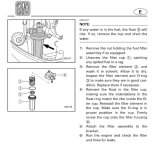Roy & Dixie
New member
Yahama F80 ,1999 carburetored, 4-stroke.
I went out last thing today to warm engine up for @ 5 min to then flush with solution I just bought. Boat had been in river and run for @ 4 hr 2-3 days ago and then run at home using ear muffs to flush. Today when I cranked engine on trailer with ear muffs, it started up immediately and ran at idle for a couple of minutes, then began to miss like it was out of fuel. I changed to a full tank, pumped fuel bulb, and attemped to restart. It fired and stumbled a couple of times, then never fired again. It has ignition from both mags and at spark plugs. (plugs are new). Fuel flows from inline fuel filter as bulb is compressed (outlet line removed). Fuel spirts several feet from lines out of each of the 2 fuel pumps. So I have good ignition and good fuel supply to the carbs. The missing and then engine shut down at that time sounded like it could have been no fuel to carbs or the engine choking down. Now I am led to think fully choked engine, because I have fuel flow and ignition, but I have always been able to start a flooded engine by either waiting a few min or opening throttle fully when cranking. There is not even one sign of engine life.
I'm glad I'm not out at anchor right now. Any suggestions?
I went out last thing today to warm engine up for @ 5 min to then flush with solution I just bought. Boat had been in river and run for @ 4 hr 2-3 days ago and then run at home using ear muffs to flush. Today when I cranked engine on trailer with ear muffs, it started up immediately and ran at idle for a couple of minutes, then began to miss like it was out of fuel. I changed to a full tank, pumped fuel bulb, and attemped to restart. It fired and stumbled a couple of times, then never fired again. It has ignition from both mags and at spark plugs. (plugs are new). Fuel flows from inline fuel filter as bulb is compressed (outlet line removed). Fuel spirts several feet from lines out of each of the 2 fuel pumps. So I have good ignition and good fuel supply to the carbs. The missing and then engine shut down at that time sounded like it could have been no fuel to carbs or the engine choking down. Now I am led to think fully choked engine, because I have fuel flow and ignition, but I have always been able to start a flooded engine by either waiting a few min or opening throttle fully when cranking. There is not even one sign of engine life.
I'm glad I'm not out at anchor right now. Any suggestions?

